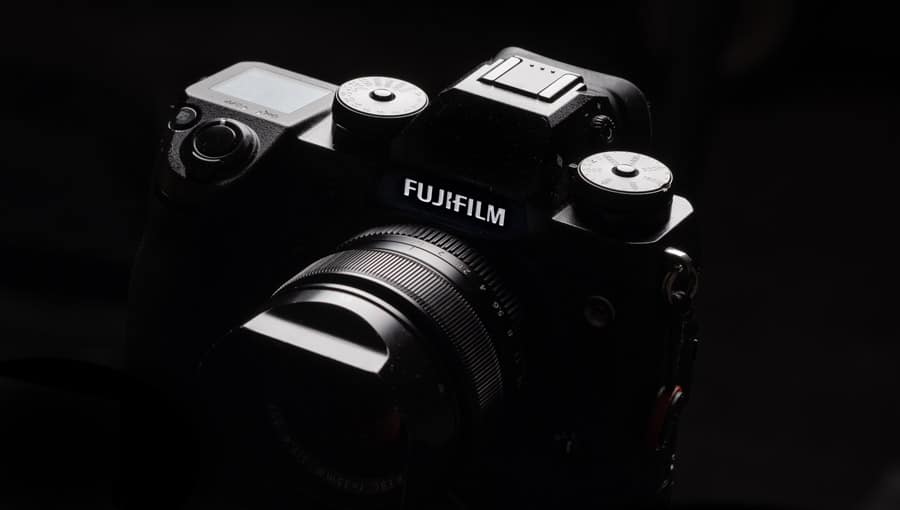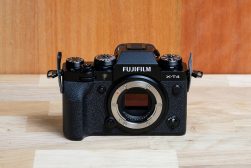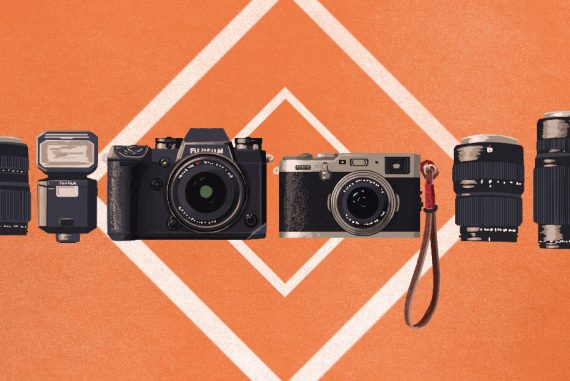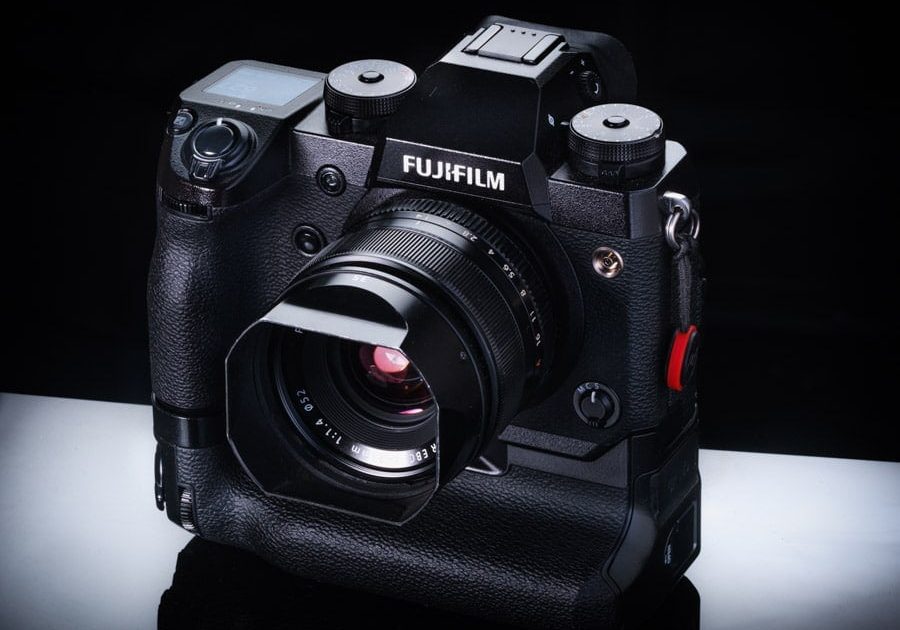
Fujifilm X-H1 Camera Review
Read this Fujifilm X-H1 review to see if this is the camera to buy over the equally excellent Fujifilm X-T3 in 2024.
This guest Fujifilm X-H1 review is by Unit Still Photographer John Platt.
This review based on my use of the Fujifilm X-H1 in my role as a Unit Still Photographer working on Film and TV drama. I will cover the positives and a few negatives in using the camera on set over the last four months.
I won’t be going into all the technical differences between the Fujifilm X-H1 , it’s predecessor, the X-T2 and how it compares to the X-T3. You can, and probably have already pursued those online.
(If not you can follow this link to the Fujifilm Global site where I have set the comparison up for you.)
Before I begin it’s important for me to state that I use Fuji Cameras for no other reason than they do the job well.
I am not paid, I am not a Fuji Ambassador. I do have a relationship with Fujifilm Australia formed over the three years I have been shooting with the Fujifilm X Camera System but that’s it. If I like a aspect of the camera I will say so, if I don’t, I will also say so.
With all Unit Stills work there is an embargo on the releasing of imagery prior to the production being released or promoted. Accordingly I am unable to include any images taken on set with the X-H1 at this time, but will update here as they become available.
Fujifilm X-H1 Review | Introduction
In a world where it’s not unusual for a production to spend hundreds of thousands of dollars on a day’s shooting, time really is money.
I have to work quickly and quietly, in a perfect world be neither seen nor heard and shooting as much as possible while the scenes are being filmed and the movie camera is rolling. I have to be flexible and so does my gear.
Without exception I work with two cameras and for the last show, a four-month drama shoot for Sony TV set in the US but filmed entirely in Sydney I used both a Fujifilm X-T3 and X-H1 .
When the Fujifilm X-H1 was released in March 2018 I took a look but held back. Like many Fuji shooters thinking of an upgrade it seemed the prudent place to position oneself as rumours of the X-T3 immediately began to surface.
Fast forward to September and I am in a quandary – X -T3 with the new X-Trans 4 sensor or X-H1 with IBIS? Solution: one of each.
With that decision made it took little time to familiarise myself with the new cameras but as the show progressed I found myself preferring to use the Fujifilm X-H1 . Not only during night shoots and darker interiors where the lighting levels were much lower and the IBIS on the Fujifilm X-H1 came into its own but in situations where it didn’t really matter which body I shot with.
Fujifilm X-H1 Review | Build
Just looking at the Fujifilm X-H1 you get a sense of its strength which is confirmed when it’s in your hands. You can feel the 25% thicker magnesium alloy compared to the X-T2 and I like that.
The exterior coating has an improved scratch resistance which equates to 8h on the mohs hardness scale. Mohs hardness scale? A measure on a scale of 1-10 of one minerals ability to scratch another. Talc is at 1, regular glass is at 5 and a diamonds at 10.
Real world weight of body and battery is 690g add the Vertical Booster Grip and additional two batteries 1082g add a Fujinon 35mm f/1.4 a further 205g.
For some that may be too much – for me it’s just right. Its light enough to carry around all day and strong enough to handle the bump and grind of the film set where gear is always moving and the odd collision is to be expected.
In my view it’s important for any camera at the professional end of the range to not only be able to deliver the goods image wise but to look the part doing so. There are those who may disagree – “does it matter what the camera looks like as long as it does the job?”
I believe there is a mindset out there that says if a camera looks professional then of course the photographer must be as well, this also works in reverse and in my world when you are meeting cast on day one of filming that you haven’t previously worked with, appearances are extremely important.
The only issue I have with the build is the small amount of movement within the lens mount. It is there with all the X Series cameras I have owned. It is most noticeable with the 55-140mm zoom. It’s no more than .25-.5mm but it is there and something that I hope Fujifilm will one day correct. With the GFX-50s the lenses are rock solid in the mount, I wonder why not with it’s smaller cousins.
[Related: Fujifilm GFX-50s Review]
Another issue I have found is nothing to do with the build of the Fujifilm X-H1 body but the lenses I attach to it. Actually not even the lenses but the lens hoods. I have found through constant use the lens hoods to the 23mm, 56mm and 90mm have become increasingly loose to a point where just brushing up against an arm or leg can twist them off the lens.
Fujifilm X-H1 Review | Ergonomics

As with all the X series cameras I’ve owned I always purchase the battery booster grip (Fujifilm VPB-XH1). With the Fujifilm X-H1 the addition of the booster grip allows my hand to fit snugly within the confines of the recessed handle.
The deeper recess on the Fujifilm X-H1 compared to both the X-T3 and X-T2 provides a more secure fit and feels substantial and solid within my hand. My thumb sits comfortably against the rear thumb rest which allows for one handed shooting, an option I don’t often take but when I need to I can literally shoot around corners.
Using the rear screen opened to it’ maximum position I can hold the camera at arm’s reach, with the electronic level activated I can be assured all my images will be straight. one example of this cameras flexibility.
I shoot with a combination of zoom and prime lenses, more often than not in manual focus mode. No matter which lens I have attached my left palm cradles the bottom left corner of the Booster Grip which positions my left thumb and index finger perfectly at the focus ring of any prime and zoom ring of the zooms.
Similarly when shooting portrait orientation the camera is comfortably supported in my left palm.
With the Fujifilm X-H1 the viewfinder block sits proud of the rear screen by 3mm – not a huge amount but as a left eye shooter it’s enough to stop my nose and face rubbing up against the screen as it does with the X-T3 where the block is aligned flush with the screen, a little thing but it makes a difference.
Fujifilm X-H1 Review | Functions
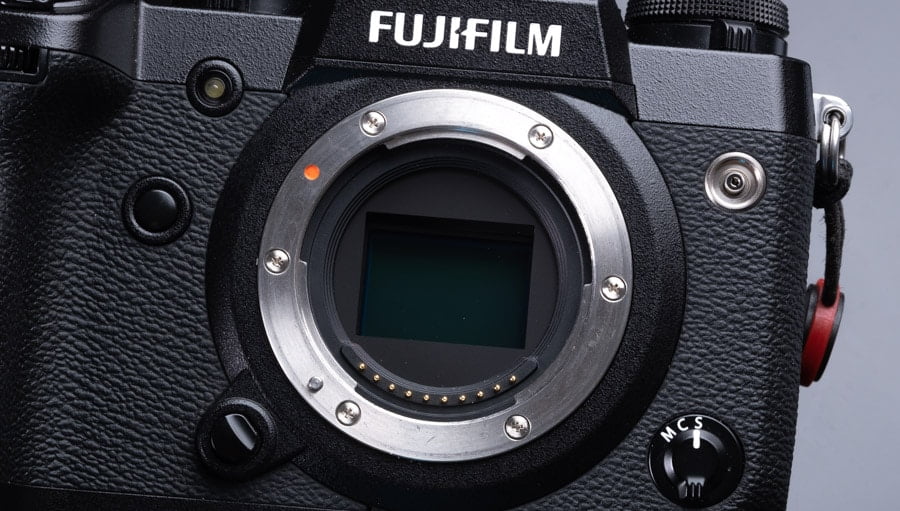
The one function that sets the Fujifilm X-H1 apart from all other cameras in the X series range is the addition of In Body Image Stabilisation (IBIS), which allows up to 5.5 stops of stabilization. For me a very welcome addition.
Previously I would be forced to use a monopod when shooting in low light with my XF56mm and XF90mm lenses. Now I can go hand held with confidence.
IBIS isn’t the only aspect of the Fujifilm X-H1 that sets it apart. Fujifilm introduced shock absorbing suspension in the form of four springs attached to the mechanical shutter. This minimizes camera shake, maximises image stabilisation and also results in the quietest mechanical shutter of all the X series cameras.
This is a big tick for me… why? When the movie camera is rolling absolute silence is required. With the quieter shutter of the Fujifilm X-H1 I can shoot single frame in all but the quietest locations without fear of being heard by the sound recordist.
The ‘Feather Touch’ shutter button itself is unique. More a hair trigger shutter button in my view and one I took a while to get used to. With the X-T1, 2 and 3 there are two definite positions when depressing the shutter button, first for autofocus and the second to release the shutter. With the Fujifilm X-H1 these two positions are much less definite which can lead to many an image being taken unintentionally.
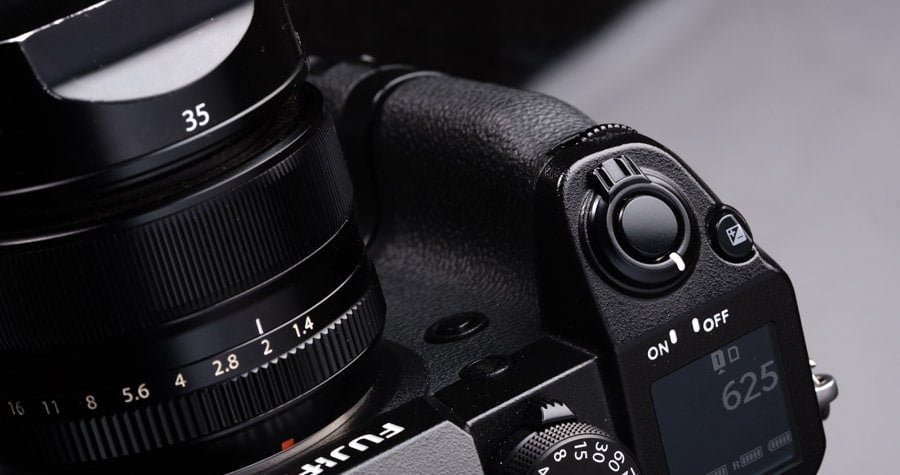
With the Fujifilm X-H1 Fujifilm have increased the resolution of the EVF to 3.69 million dots from the 2.36 million dots on the X-T2. A clearly visible increase which has made manual focus even more accurate and precise.
Let’s step outside the body to its exterior and look at the various buttons and dials.
Most obvious is the replacement of the exposure compensation dial with the sub LCD monitor. For me a welcome move and extremely useful for quickly checking your most important settings. It is customisable in both Stills and Movie mode.
The exposure compensation is now a small button to the right of the shutter release. As a manual shooter I have no need for this function so have customised it in the Setup/Button/Dial Setting/Function (Fn) Setting to trigger the Face/Eye Detection Settings..
To the right of the rear screen you have from top to bottom your Focus Toggle Switch, the Menu Button surrounded by 4 Selector Buttons and finally the Display/Back Button. Fujifilm have moved the Quick Menu button from the rear of the camera to the rear of the Thumb Rest. I
like the idea of repositioning the Q Menu Button to allow for a more space but question its placement on the rear of the thumb rest. I would often activate the Q Menu as I raised the camera to my eye if my thumb didn’t exactly hit the Thumb Rest sweet spot .
Fortunately for me the Q Menu is not something I use and it’s possible to disable it. Menu/Setup/Button Dial Setting/Lock/Lock Setting/Selected Function/Back/Function Selection and select Q Button.

The Fujifilm X-H1 has eleven customisable buttons and if you need them four customisable swipes on the LCD screen, left and right, up and down. I use three of these on a regular basis and admit to forgetting at times what the others are set to. Most often I’m switching between Mechanical and Electronic shutters followed up by Colour Temperature and Film Simulation.
I actually have one button set to Large Indicators Mode, not because I need it but I have found that every now and then the camera slips into the Large Indicator Mode and I need to return it to it’s normal mode. Similarly the X-T3 has a similar idiosyncrasy but with the Sports Finder and similarly I have assigned a function button to Sports Mode so I can turn it off.
Arriving with the Fujifilm X-H1 is the option of using the Front and Rear Command dials to set Shutter Speed, Aperture and ISO. For me this is the most exciting addition to the functionality of the camera other than IBIS, greatly streamlining the exposure setting process. I no longer have to remove my left hand from the camera to change the ISO on the top dial nor have to adjust Aperture on the lens.
The spring loaded Command Dials are able to accommodate two functions each. I have programmed the cameras Front Dial to change both Shutter Speed and ISO with the Rear Dial programmed to adjust Aperture and Focus Check. This is a function I had with my Canon 5D mk2 and found it frustrating that the command dials were there on the Fuji cameras but were not programmable to achieve this up to now.
Finally though it’s here and I must say with the ability of each dial to accommodate two functions it’s an improvement on the Canon version.
Another of my favorite functions is the ability to shoot remotely using Wireless Communication. I purchased a boom operator’s pole and attached a small ball head to the end usually reserved for the Mic. The pole extends three metres which allows me to shoot from high angles while controlling all exposure options plus focus from my iPhone (free Fujifilm app required).
Fujifilm X-H1 Review | Performance

Whenever discussions turn to digital cameras there are two aspects of any camera that will always get a mention: autofocus and low light performance.
I have specified that I primarily use manual focus and find it is the quickest of all the focusing options, especially with MF assist enabled and for me this is (peaking, low, yellow). Quickest because the process of a lens autofocusing is not just the milliseconds that it takes for the lens to lock onto your subject.
There are additional steps to perform prior to depressing the shutter halfway to lock your focus and it’s with these that I get a little frustrated with the auto focus process on not only the Fujifilm X-H1 but all the X series cameras I’ve used.
The only practicable AF mode for me, apart from AF-C Tracking is single point, and at that the smallest or next to smallest of the six size options. Here’s the rub: the smaller the square the slower it is to position the point accurately in the viewfinder using the rear toggle lever, and if I use a larger square it’s less precise.
This was borne out when I was using my XF90mmF2 on a night shoot where light levels were very low but AF was practicable because there wasn’t a lot of movement so didn’t have to chase focus. Using the smallest square in Single Point Mode the focus locked on quickly and accurately whereas if I used a larger square the focus would tend to hunt a little.
For me the process is slowed by two things. One, the number of focus points and two, the way you are forced to maneuver the focus square by use of the rear toggle lever which for me is awkward. Even a second or two is a frustratingly long time to take to position your focus point.
Thankfully once you’re there the AF is very quick and accurate but it’s the getting there that’s the issue. I remember in my days as a Canon shooter the camera had less focus points and the ability to toggle through the focus point by means of the rear command dial. It was a quicker more efficient process.
Perhaps a third option of far less points along with the current options of 91 and 325 points is one Fuji could look at.
The AF focus mode that works extremely well in my work is the AF-C, in tracking mode. Keeping oncoming vehicles, people running towards camera in focus is a breeze. The mode has a number of different preset options or you can manually set your parameters. Once the camera locks onto its subject it won’t let go.
I am most satisfied with the low light performance of the X-Trans CMOS III sensor. I frequently have to shoot with ISO’s around 8-10000 during night shoots to get a usable shutter speed and aperture. At this ISO I am able to shoot around 1/100th sec stopped down slightly – f1.8-f2. I hate shooting wide open as no lens is at its best there and depth of field is so much more reduced.
It’s due to the performance of the sensor that I can boost the ISO that extra stop. Additionally the noise is not unpleasant in appearance resembling film grain which gives the images an atmospheric feel which is not unwelcome. Also important to note that it’s in these low light situations the inbuilt IBIS of the Fujifilm X-H1 comes into it’s own.
If necessary I perform slight noise reduction in post but only slight.
Fujifilm X-H1 Review | Image Quality
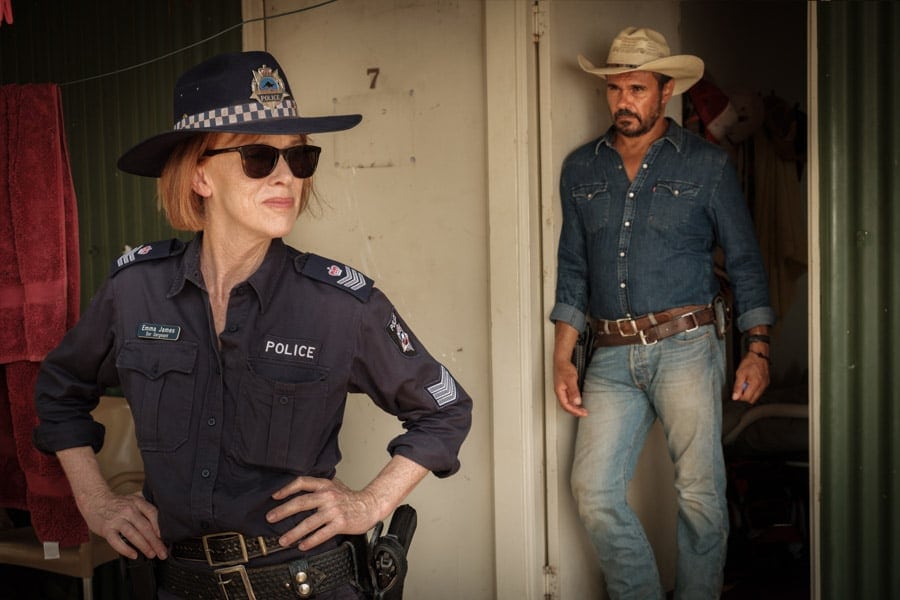
Judy Davis and Aaron Pedersen ‘Mystery Road’ ABC TV 2018
As a working professional I cannot fault the quality of the optics of the Fujifilm System. I use two zooms, the Fujinon 16-55mm f/2.8 and the 50-140mm f/2.8, and in the primes I have the Fujinon 16mm f/1.4, 23mm f/1.4, 35mm f/1.4, 56mm f/1.2 R and the 90mm f/2. I also have the Fujinon XF2Xx2 teleconverter (extender).
The lenses are sharp and render fine detail beautifully. I primarily use manual focus and find that the lenses vary in their sensitivity and consistency of resistance, ‘feel’ on the lens barrel when used in this mode.
[Related: Shotkit’s favourite Fujifilm X Lenses]
I find the 35mm f/1.4 and 56mm f/1.2 R are least responsive to fine adjustments and for some reason the focus direction on the 16mm f/1.4 and 23mm f/1.4 cannot be changed using the Setup/Button Dial Setting/Focus Ring options.
All other lenses in my kit respond to the Clockwise/Counter clockwise options, why not these two I wonder. Not a game changer and something you get used to but a little frustrating at the same time.
In the past image quality was primarily based on the quality of your lenses. With the arrival of digital it’s now more a combination of optics and sensor. If you shoot RAW then additionally your RAW processor of choice plays a part.
For many years I’ve used Adobe Lightroom Classic for file management and RAW processing. I do 80-90% of my grading with Lightroom and these days most of that is done on my iPad Pro using Lightroom Mobile.
The combination of Lightroom Mobile and the iPad is the perfect duo. I can grade on set during any down time saving me hours of work at home. I also use it to show off my photos to current or prospective clients, it’s my mobile portfolio and something I can’t do without.
Unfortunately what Lightroom Classic is not good at is processing Fuji RAW files.
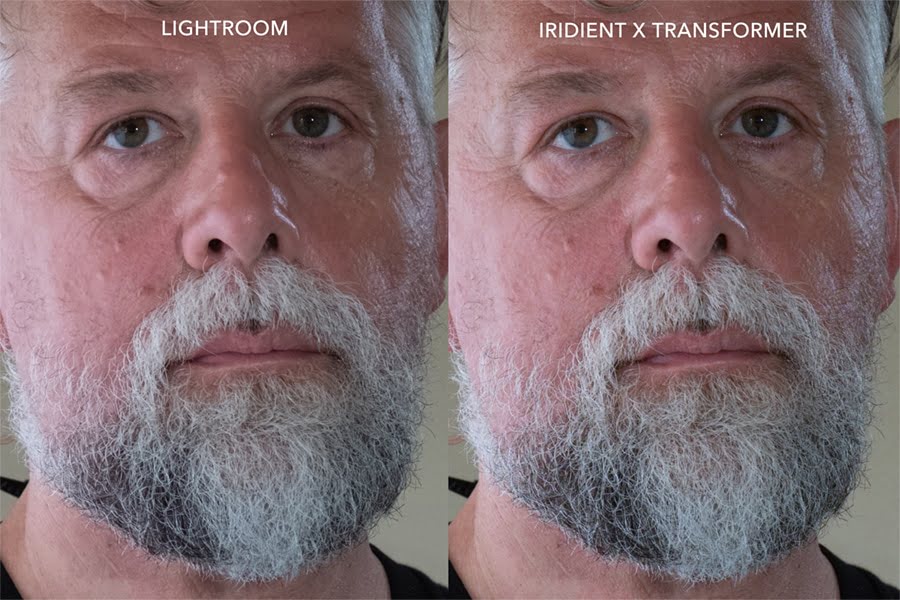
I had heard mention of this before but as Lightroom is integral to my workflow I didn’t pursue things. This all changed after I had purchased my Fujifilm X-T3.
At the time of purchase Lightroom was unable to process the new X-T3 RAW files so I had to find an alternative. I’m a member of the Fuji X Aus users group and was recommended Iridient X Transformer, ON1, and Capture One as alternatives.
I tried all three and was honestly surprised at how much better all three do in processing Fuji RAW files. The finer details pop and it’s immediately clear that the Fuji lenses are in fact even better than I thought.
Of the three Iridient is the only standalone RAW processor which also comes as a Lightroom Plugin and for me this was the clincher.
Whichever you choose one thing is for certain, all three do a better job at processing Fuji RAW files than Lightroom and will improve your image quality.
Fujifilm X-H1 Review | Conclusions

I love this camera.
For me it is still the top of the line Fujifilm Model with two things making it stand it apart from X-T3.
Firstly how it feels in my hand, two words… solid and secure.
Secondly, IBIS. Hands down more important in my work than the X-Trans 4 processor and improved video capabilities of the X-T3
It’s my go-to body in every situation to the point where I can see myself putting the X-T3 on the market and buying a second Fujifilm X-H1 .
The ratings below are based on a comparison between the X-H1 and my previous camera the X-T2
I hope this review has been helpful.
Cheers JP





